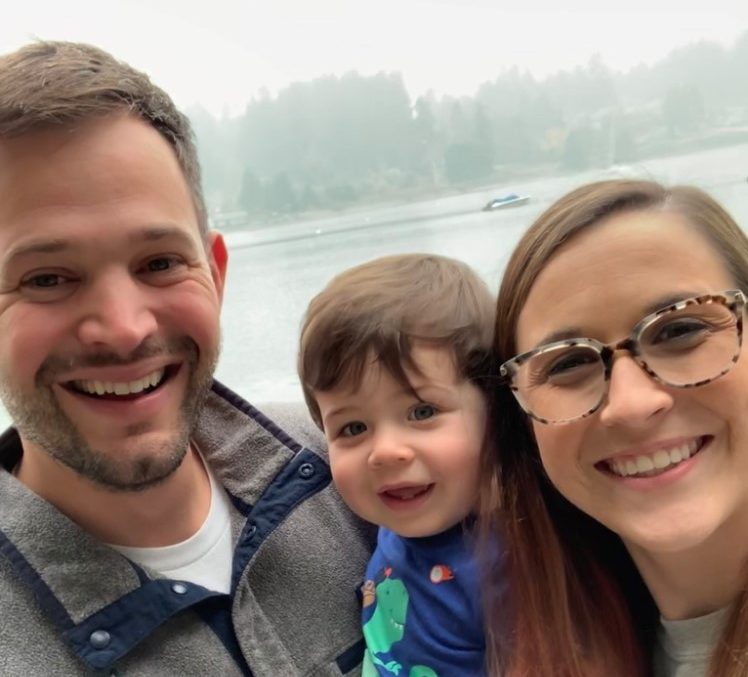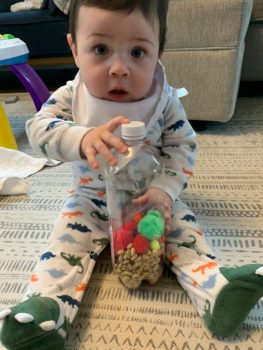
In 2020, the TODAY Show featured Dr. Dimitri Christakis, director of the Center for Child Health, Behavior and Development at Seattle Children’s Research Institute, in a story about the evolving digital age and the effect media has on children and their developing minds. A year later, Jake Ward, NBC News correspondent, is following up to learn more about how the pandemic has impacted the use of digital devices. Watch as Ward and Christakis explore again the intersection between a child’s development and the digital world.
The below article features a family navigating the challenges of media usage during the pandemic and their participation in a study led by Christakis to better understand play-based activities.

Katie Favilla is a first-time mother. When her son Joe Favilla was born, she and her husband had a great support system, which included friends and family. That changed in March 2020. When the world shuttered because of COVID-19, Joe was 6 months old. The world seemingly halted, and all the things they loved to do outside of the home did too – zoo trips, grocery store runs, pancake breakfasts at IHOP.
“Having that network of people we could turn to just stopped,” Favilla said. “There were no breaks. The days were long, and we didn’t have an extra set of hands. It was just my husband and me. It was emotionally draining – the feeling that it’s all on you.”Christakis says the feelings Favilla and her husband have felt during the pandemic are common. Families around the world have grappled with similar challenges, and finding ways to juggle work, school and raising healthy children may feel like a Sisyphean task.
Favilla said when the pandemic hit, their media usage went up. Joe’s screen time didn’t skyrocket, but they did have to bend their own rules sometimes.
“We tried to still have a handle on it,” she said. “But there are only so many DIY activities you can do. Screen time is going to happen.”
Media usage during the pandemic
Christakis is an international expert on children and media and his current research aims to help inform parents so they can make better, more informed media choices. Before the pandemic, understanding the intricate relationship between media and a child’s cognitive development was important, but now the need for this research seems more pressing as so many families struggle with limiting screen time.
Christakis’ lab at Seattle Children’s Research Institute focuses on children from birth to age 5 and examines actionable strategies to help promote a child’s healthy social, cognitive and emotional development. The lab’s researchers have published a number of landmark findings aimed at helping every child live the healthiest and most fulfilling life possible, the mission and cornerstone of Seattle Children’s. For years, Christakis and his colleagues have studied how various types of toys and digital media have improved development or lead to behavioral issues in children. For instance, Christakis and his team were among the first researchers to discover that television exposure, especially fast-paced programming, can lead to attention problems, and found that playing with blocks can improve young children’s language development.
Christakis said he and his colleagues have noted significant increases in media usage among children. Christakis says data is still emerging, but trends and anecdotal observations have seen usage in some instances double. One concern is that increased media use is associated with anxiety, depression, obesity and aggression.
Across the country, hospital systems are seeing an alarming trend in children presenting with mental health issues. At Seattle Children’s, hospitalizations for depression have increased significantly. Another concern is that there is not enough research to completely understand the effects of media use.
Christakis isn’t sounding an alarm quite yet. These diagnoses aren’t occurring simply because of media use. These are associations and not definitive causes. What concerns Christakis are the types of activities that are being displaced because of media use. His research has shown that children will spend more time on digital devices than playing with their favorite toy. In the absence of an iPad for instance, can a child participate in activities that would be more likely to benefit their social and cognitive development?
Researching play
 To better understand how children play with different toys, both digital and tangible, Christakis and his team have launched a study called DAISY. The lab is currently enrolling participants for the study to better understand how different play-based activities influence attention and language. Joe recently went through the study. Favilla completed some questionnaires, and they attended one in-person visit to Seattle Children’s Research Institute. During the visit, Joe engaged in some play-based activities and researchers recorded his heartrate and breathing.
To better understand how children play with different toys, both digital and tangible, Christakis and his team have launched a study called DAISY. The lab is currently enrolling participants for the study to better understand how different play-based activities influence attention and language. Joe recently went through the study. Favilla completed some questionnaires, and they attended one in-person visit to Seattle Children’s Research Institute. During the visit, Joe engaged in some play-based activities and researchers recorded his heartrate and breathing.
This is the second study Joe has been enrolled in.
“I come from a science and health care background,” Favilla said. “It’s great to be part of the scientific community. The more information we have about something, the more the results can help scientists and researchers. Together, we can help so many kids.”
Favilla said being involved in the study has been an exciting opportunity. She’s looking forward to receiving an assessment from Christakis’ team.
“The information will be great,” she said. “As parents and mothers, we also have to take things with a grain of salt. We’re all just trying to survive and do what’s best. It’s important to know what you’re striving toward, but we also have to give ourselves grace if we feel like we’re falling short. You’re not failing if you let your child use an iPad.”
Next steps
Christakis doesn’t advocate for a world devoid of digital devices; he hopes to find a balance and understand how different media usage affects the developing brain.
“Digital devices have become ubiquitous,” Christakis said. “Our goal is not to get rid of media, our research hopes to inform better media choices.”
In a policy statement co-authored by Christakis, recommendations include:
- For children younger than 18 months, discourage use of screen media other than video-chatting.
- For parents of children 18 to 24 months of age who want to introduce digital media, advise that they choose high-quality programming/apps and use them together with children, because this is how toddlers learn best. Letting children use media by themselves should be avoided.
- In children older than 2 years, limit media to 1 hour or less per day of high-quality programming. Recommend shared use between parent and child to promote enhanced learning, greater interaction, and limit setting.
Being involved in the study has also made Favilla reflect on her own media usage.
“We are so engrained and engrossed in our phones,” she said. “It’s almost like you have to regulate yourself and emulate what you want your children to do. When I was a child, we didn’t have the world at our fingertips. I think it’s okay to not be connected to the world 24/7.”
To learn more about the DAISY study, please call 206-884-TOYS or email [email protected].
Any information shared in comments is visible to other readers of this post; interested families are encouraged to contact the study team directly.

